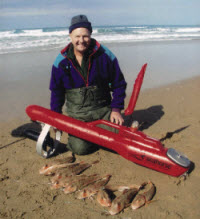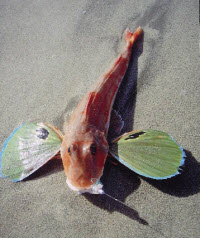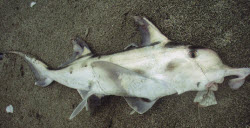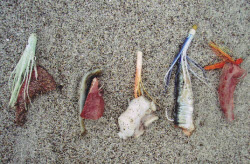How to fish with a Kontiki
I’m a surfcaster first and foremost, but there’s also something I find alluring about setting a kontiki from the shoreline.
Is it the mystery of what’s going to be on the next hook, the opportunity to sit back and send out a variety of different baits well beyond casting range, the chance to put fish onto the table when the rod fishing becomes very quiet, or all of the above?
 Certainly, when the seasons change from winter to spring and autumn to winter, I like to run a few sets with mates off the Hawke Bay and Bay of Plenty beaches. The prime targets are snapper and gurnard, which begin to migrate from the depths during early spring, and push out during late autumn. These are times when they are feeding well and putting on condition, but when they also tend to be out of the surfcaster’s range.
Certainly, when the seasons change from winter to spring and autumn to winter, I like to run a few sets with mates off the Hawke Bay and Bay of Plenty beaches. The prime targets are snapper and gurnard, which begin to migrate from the depths during early spring, and push out during late autumn. These are times when they are feeding well and putting on condition, but when they also tend to be out of the surfcaster’s range.
In this article I will share a few techniques, ideas, baits and tackle to put some fresh fish on your family’s table when out fishing with a kontiki.
What’s a kontiki?
Kontikis traditionally came in the form of a very small pontoon-type boat, raft-like structure, kite or inflated object designed to be taken offshore by the wind (in offshore wind conditions). In more recent years however, electric kontikis have been developed, powered by 30-46lb (13-16kg) thrust Mercury electric motors running off 12-volt gel-cell batteries outputting between 16 and 22 amps. These allow a craft to run out to nearly two kilometres offshore in optimum conditions, but they can be programmed to run shorter distances if necessary.
The obvious advantage of an electric kontiki over a wind-powered device is that it can be set in almost any conditions (onshore/side winds, swell, strong side currents etc). Also, the pull is constant, unlike a sail-powered kontiki with wind fluctuations that may allow the crabs time to eat your baits before the hooks have reached their destination. Providing the user knows how to use the kontiki properly, most electric kontikis have a fairly accurate tacking system to set them straight offshore. Most electric kontikis can out-distance a wind-powered sail kontiki before the lolly melts and drops the sail onto the deck and, subsequently, the attached weight to the bottom of the ocean.
Having said this, a sail-powered kontiki and line may only set you back around $500, whereas an electric kontiki and line may cost as much as $3700. But, same as with most gadgets and gear, if you plan on using it a lot, want it to perform well on a consistent basis and can afford it, I suggest not skimping by purchasing cheap alternatives; instead, buy the best and have no regrets later on.
I have been using a Seahorse electric kontiki for the past five years, have had many hours of enjoyment from it, and caught plenty of fish, too. For me, the Seahorse offers proven performance and reliability (also, working in the tackle trade, I have sold over 200 of these to very satisfied customers!). It has a solid, watertight electric control (activated by a magnet), is simple to use, and its design enables it to head out through broken surf to the desired preset-timed location with ease. (Check out Seahorse: www.seahorse.net.nz.)
What else is needed?
 A hand-reel or electric winch filled with line. Whether you’re setting a sail-powered kontiki or an electric kontiki determines the size spool required. Although 1000m of 100kg line is sufficient for a sail-powered kontiki, an electric kontiki needs a spool that holds 2000m of up to 150kg line. Your options are then: to have a manual-wind, which should be two-person operation (although I have done this by myself, it becomes quite a chore), ideally in a 3:1 ratio, or to deploy an electric winch running off a 12-volt battery source. Most hand-reels are made of plastic, so it is of the utmost importance that you hand-pull the line first before carefully winding it onto the spool under a lighter tension. Directly winding onto the plastic spool under tension will result in the spool imploding and becoming useless.
A hand-reel or electric winch filled with line. Whether you’re setting a sail-powered kontiki or an electric kontiki determines the size spool required. Although 1000m of 100kg line is sufficient for a sail-powered kontiki, an electric kontiki needs a spool that holds 2000m of up to 150kg line. Your options are then: to have a manual-wind, which should be two-person operation (although I have done this by myself, it becomes quite a chore), ideally in a 3:1 ratio, or to deploy an electric winch running off a 12-volt battery source. Most hand-reels are made of plastic, so it is of the utmost importance that you hand-pull the line first before carefully winding it onto the spool under a lighter tension. Directly winding onto the plastic spool under tension will result in the spool imploding and becoming useless.
Electric-winch options tend to be made of thick, plated, treated steel, and the line can be wound on under quite a load. This is a much easier option for a single-man operation. The mainlines are ideally 100kg upward to ensure a longer line life, resisting the wear and tear of stones, floating debris and thrashing fish better. It also ensures that your line will be able to drag in some serious fish – as well as your kontiki, of course.
Clips: Either long-line or triangle clips are used to attach the traces to the mainline. Long-line clips require a pre-prepared, stoppered section of line – usually 200 metres of it, with 100 stoppers set two metres apart. When using stoppered line, you can attach your long-line clip every second or third spacing, allowing the trace to slide within the confines of a two-metre stoppered section. Long-line clips are easier to push on and pull off a stoppered line when using an electric kontiki, as it pulls the line out quite fast. However, this means you’re only effectively fishing within the confines of the 200-metre stoppered section. With triangles, you can attach a trace anywhere you wish along the entire length of the line, meaning you can set your baits from the water’s edge all the way to your craft.
Hooks: There are only two styles of long-line hook I would consider using on a beach kontiki line, and these are the traditional Japanese Tainawa long-line recurve hook in sizes 18, 20 or 22 or a Mustad Ezi-baiter long-shank recurve in 11/0 size. Both hold their points well, don’t rust as quickly as other hooks, and are cheap to replace when lost to snags or bitie fish such as sharks and barracouta.
Trace line: Either a fluorocarbon trace line such as Black Magic in 40lb (18kg) breaking strain or tough mono such as Black Magic 60lb (27kg) Tough trace is recommended. Go heavier or use thin wire traces instead, and it can be very hard or nearly impossible to break free if you get your traces snagged. A lost hook is much cheaper than a lost kontiki! I’ve had good snapper bite through 60lb trace before, but with their dentation, they are just as likely to crush 100lb trace if the fish is big enough and the line ends up in the wrong part of the jaw.
Sinker weights: When using pre-stoppered line, I usually use four, single, eight-ounce weights, attaching the first between the leading two stoppers, with subsequent weights placed after every eight traces. Using the barley-sugar drop system on a sail kontiki, I have a 24-ounce sinker that drops the line to the bottom. I prefer to have my weights spread amongst my stoppers, as this allows my traces to be constantly on the bottom, where gurnard and snapper generally feed. While there is no foolproof way of attaching enough weight to stop your kontiki from drifting when using either system in rough water conditions, if your baits are drifting along the bottom, you’re covering and fishing more ground, aren’t you?
Trace additions: The recent addition of clear tubing to traces spanning 90% of the trace’s length prevents traces tangling around the mainline. The traces are then able to present the baits a lot more naturally and make them less likely to spook fish. If the crabs are a problem, the use of traces with free-running floats 18-25mm in diameter will lift the bait off the sea floor – but only the length of the trace – helping to ensure there will be some bait present when a fish swims past, and also enabling the bait to be more easily seen.
Bling on your traces: I have been using lumo-headed ‘Needlefish’ skirts on my kontiki traces for a few years now, and just like when I’m surfcasting, they work especially well as the line’s being set or retrieved, performing in much the same way as a lure. The extra movement and colour increase the chance of a bite during the daylight, and when lit up by a torch or head lamp at night, the lumo aspect will help the fish locate your bait in darkness. I have tested this to great effect at night on snapper in the Bay of Plenty – be it lumo-skirted lures, lumo beads or lumo tubing, lumo is a must for night fishing! As for flashers, these work much the same as a flasher rig does when cast out on a line, with the sparkle and movement of the material attracting more fish in and then increasing the chance of a bite afterwards, too.
Soft-baits? To be honest, the verdict is still out on that. Yes, they do catch, but they only last a couple of sets before the crabs chew them to bits, as do small picking fish. Personally, I believe they are a novel idea but an expensive option.
Baits and bait preparation.
 Depending on the species of fish you’re targeting, it is a good idea to have different bait options available. Some are very cheap options, but these can be just as effective as the more expensive ones. However, what you need to consider is the availability, durability and, foremost, the intended target species’ bait preferences. Consequently, my number-one favourite is fresh kahawai. A great all-rounder, it is dynamite on gurnard and snapper, also catches a wide variety of other fish species, and, most importantly, is also durable and easy to bait up. Small strips or thumb-sized cubes hooked just once with the point and barb protruding nicely ensure well presented baits that catch effectively.
Depending on the species of fish you’re targeting, it is a good idea to have different bait options available. Some are very cheap options, but these can be just as effective as the more expensive ones. However, what you need to consider is the availability, durability and, foremost, the intended target species’ bait preferences. Consequently, my number-one favourite is fresh kahawai. A great all-rounder, it is dynamite on gurnard and snapper, also catches a wide variety of other fish species, and, most importantly, is also durable and easy to bait up. Small strips or thumb-sized cubes hooked just once with the point and barb protruding nicely ensure well presented baits that catch effectively.
Other worthwhile alternatives include fresh trevally, mackerel, barracouta and, if I had a ready source of it here, grey mullet would be tops! Another great but more species-specific bait is octopus. It sticks like pooh to a blanket on the hook, and makes an excellent, hardy, snapper bait. The substitute to this is obviously squid, but again, don’t use massive chunks of it, especially as this can see it spinning and tangling around the mainline. However, if on a beach that’s more likely to produce gurnard than snapper, then stick to fish-flesh baits.
Another great option is salted baits. If I have any surplus kahawai or barracouta, I make my own, whacking a few fillets into an oven dish containing salt, flipping both sides into the coarse, granulated rock salt, then placing them in another tray and leaving in the fridge overnight. Next day, the surplus liquid drawn out by the salt is drained off, the fillets left for another day, drained again, then bagged or pre-cut into firm, fresh-salted baits. These baits will stay on the hook longer, and can be used straight out of the freezer, as the baits produced are pliable due to their increased salt content.
Another cheap and effective bait option involves taking your kids down to the local wharf to catch sprats for fresh bait. This gives kids the sense they’re contributing to the food-gathering process – and it’s great fun! Other baits I have used successfully include tuatua, crab, cray tail and carp.
What’s the catch?
I’ve caught the following species of fish on my kontiki: snapper, gurnard, trevally, kahawai, kingfish, blue cod, red cod, barracouta, sole, spotted smoothhound, bronze whaler shark, tope shark, spiny dogfish, carpet shark, elephant fish, skate, eagle ray, stingray and last, and least, BLIND EEL (yuk!). The target species will vary from location to location and season to season; in the warmer months in Hawkes Bay we catch better quality fish such as snapper, gurnard, trevally and the occasional kingfish, but in winter, as the water cools down, we can catch a line full of dreaded spiny dog and tope sharks.
When to fish
 Any time is good really, however you may find some locations produce better at night than during the day, and if running sets during the day it can pay to vary the distances set. For example, when I go up to the Bay of Plenty, I set the full distance during daylight hours when conditions are dead near the shoreline. After dark the fish move right in close though, so I run very close sets during this time. It’s a matter of experimenting with your set distances, as well as asking local fishers or nearby tackle stores for advice.
Any time is good really, however you may find some locations produce better at night than during the day, and if running sets during the day it can pay to vary the distances set. For example, when I go up to the Bay of Plenty, I set the full distance during daylight hours when conditions are dead near the shoreline. After dark the fish move right in close though, so I run very close sets during this time. It’s a matter of experimenting with your set distances, as well as asking local fishers or nearby tackle stores for advice.
Watch out!
Glass the water with binoculars before setting your kontiki. Be wary of other kontikis set in the area. That joker down the beach may think he’s set his kontiki straight, but how much has he had to drink and how long has he been sitting in the sun? A crossed kontiki line is no fun for anyone, and a few minutes spent glassing the water can avoid an embarrassing and frustrating situation.
Not only other kontikis, but cray pots, set-nets, setlines and marker buoys are all potential obstacles to be wary of. Then it’s up to you to practice your beach etiquette. There’s miles of beach, so don’t try and squeeze into a small area in between other users, regardless of the “that’s where I caught all my fish the last time” tales. Tangles and aggro from other beach users is no fun. Whether they are surfcasting with one or two rods, or have a kontiki out near your ‘favourite’ spot, leave them in peace and move further along the beach so everyone has space.
Be careful when driving down the beach on a quad bike or 4WD wagon: keep an eye out for other beach users and go around their gear, not over it! I like to erect a flag when setting a long-line on the beach, so other beach users can identify that there is a long-line nearby.
Snagged
 Should your line become snagged, be careful not to over-pull the line. If traces are snagged, provided your trace line is 60lb (27kg) or below, you should be able to bust the trace. However if the mainline snags, try heading off down the beach a couple hundred metres left and right to see if you can free the snag before undertaking any drastic measures. Drastic measures include driving up the beach into the sand dunes trying to pull the snag free. In this scenario you will probably sink your kontiki craft or break the mainline, both potentially resulting in a lost kontiki (a bit painful if it’s a nice, shiny, electric kontiki). A better option is to get someone with a boat or a kayak to paddle out and secure your kontiki before pulling the mainline to breaking point.
Should your line become snagged, be careful not to over-pull the line. If traces are snagged, provided your trace line is 60lb (27kg) or below, you should be able to bust the trace. However if the mainline snags, try heading off down the beach a couple hundred metres left and right to see if you can free the snag before undertaking any drastic measures. Drastic measures include driving up the beach into the sand dunes trying to pull the snag free. In this scenario you will probably sink your kontiki craft or break the mainline, both potentially resulting in a lost kontiki (a bit painful if it’s a nice, shiny, electric kontiki). A better option is to get someone with a boat or a kayak to paddle out and secure your kontiki before pulling the mainline to breaking point.
Name it, insure it!
If you value it, insure it with your insurance company. You must name it by law anyway with your name and phone-contact details, but that way if it comes adrift and you’re lucky enough to have an honest person find it, then there’s the chance it may be returned to you. Just make sure you reward the honest person with a fish or two, or a bottle or three.
Safety first
Although you can set motorised kontikis in rough water, the fishing generally isn’t that great when the sea’s fairly turbulent and there’s a lot of rubbish in the water that can tangle in your line and possibly jam your prop. However, if determined to set the kontiki, always practice safety first. I’ve seen some absolute shockers, and it ain’t fun getting knocked over and going turtle-up in a large swell. Pick your moments to set the kontiki in between swell sets – there will be a lull. But don’t run down, throw it in and hope for the best; chances are, you and your kontiki will get busted up. Wear a PFD if really determined to keep fishing in these conditions; that way, if you do get sucked into the surf, you can inflate your jacket and get back to safety. A fish isn’t worth your life and there’s plenty more days to fish. Personally, I don’t bother setting my kontiki in anything exceeding two metres as it’s usually a waste of time.
Care for your catch
 So now you’ve caught it. Return what you don’t want or need to the sea, rather than let it bake in the sun and die an unpleasant death. It’s my pet hate!
So now you’ve caught it. Return what you don’t want or need to the sea, rather than let it bake in the sun and die an unpleasant death. It’s my pet hate!
If you have a gut-hooked fish you wish to return, cut the trace – what’s a 10-cent hook? Chances are, the hook will rust out over time and the fish will live to provide another angler with the thrill of capturing it. If you start prodding at a fish’s gills and guts, ripping at them, by the time you return the fish to the sea its fate will almost certainly be sealed.
As for those fish destined for the table, dispatch your fish with a knife or iki spike, then keep them cool and out of the sun in an ice-filled chilly bin. Big hunks of ice or bags of salt ice help keep the fish fresh and in prime condition to eat. If keeping a shark to eat, trunk it (remove the fins and gut section) and rinse in saltwater straight away, before storing in the iced chilly bin.
Know your limits
The current regulations for our area are as follows: 25 hooks per long-line, 20 finfish per day, including an additional limit of 10 snapper in the central area and nine in the Auckland east to Bay of Plenty area. For those outside these areas, consult your local MFish regulations.
At the end of the day, take only what you need for you and your family. As the saying goes, fish keep better in the sea.
 |
This article is reproduced with express permission of |
Fishing Reports Visit Reports
Canterbury Fishing Report - 04/04/24
Fish galore! Coming off the back of Easter Weekend and with some very nice weather... Read More >
Raglan Fishing Report - 04/04/24
Excellent snapper action There is some excellent autumn snapper fishing straight out and up the... Read More >
Bream Bay Fishing Report - 04/04/24
Whangarei Harbour fishing well Like the weather, the fishing has been patchy throughout Bream Bay... Read More >
Hauraki Gulf Fishing Report - 04/04/24
Party time! Inshore fishing and offshore fishing are on now. It’s that perfect time of... Read More >




Comments